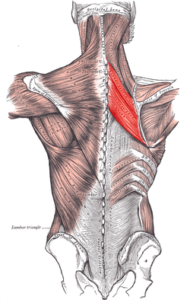What I learned This Summer, Part 1; Rhomboids vs. Pectoralis Major

It’s back to school day here at my house, which went relatively smooth. Not that I’m surprised. My kids seem to like school. You see, their primary caregivers all summer were their grandmas, a handful of camp counselors and yours truly (in between clients). I make them do things like chores and outside play and reading, and they get very minimal screen time. So, school seems like a pretty fun change of pace; they get to see friends, there’s a predictable schedule of snacks and screens are incorporated in their learning time (don’t get me started). So, it’s a win-win all around! Now that we have a routine again, I can extend my business hours to include more client sessions AND more admin time (yay, bookkeeping and blogging). But I don’t want to give the impression that learning wasn’t still happening during summer vacation because, I for one, learned a LOT.
I’ve decided that my next few blog posts will be about things I learned over the summer. They will be delivered in the order in which I remember them, not in which I learned them (sorry chronology nerds, my brain doesn’t work that way). They will span the categories of massage techniques, business development, trivia, personal growth and of course, healthy lifestyle stuff, cause that’s kinda my jam.
What I learned this summer; The Dual – Rhomboids vs. Pecs
When the upper back hurts between the shoulder blades, I used to think the rhomboids (muscles that connect the shoulder blades to the spine- see illustration below) needed to be worked (kneaded, stripped, frictioned, whatever). And indeed, doing this felt “good” to most of my clients who complained of upper back pain of this sort. However, no matter how often I saw them and did this work, they would always present with the same complaint when I saw them the following week/month. So what the heck, right!?

Rhomboids in red – red cause they’re ANGRY!
Enter the concept of antagonist muscles. Most (maybe just many, I don’t know, I’m not a physiologist) major movement muscles have an antagonist – a muscle that does the opposite movement. The most familiar example of this is the quadriceps/hamstrings relationship. When you straighten your knee, your quadriceps engage (hammies relax), when you bend your knee, your hamstrings engage and your quads relax. They can both engage at the same time (if you hang out like that you will look awkward, but I’m not judging) and they can both relax at the same time (which is how I prefer to spend my time at the lake). When it comes to rhomboids, their job is to retract (pull together) the scapulae (shoulder blades). But I noticed on lots of my clients with upper back pain, their scapulae were spread pretty far apart while resting, in other words, stretched. And you know what happens when you stretch a muscle for a long time?
Back to the quads for a moment: Imagine pulling your heel up to your butt all day, every day . . . how would your quad feel? It’d freaking BURN like a whole milk half caf latte with extra foam and a shot of CBD oil on a bumpy commute to work (shoutout to my barista friends and fam!). So what the heck was pulling at all these rhomboids to the point that they were stretching and making my clients hate their backs? I needed to figure out what muscle pulls the shoulder blades apart . . . enter; Pectoralis Major.
Me: “Oh hey, pectoralis major, why you tuggin’ on the rhomboids?”
Pecs: “Well, my people work at computers a lot, then they get on their phones and stoop over them with their shoulders rolled forward, then they get in their cars and drive forever with their seats away from the steering wheel, and sometimes they cut hair, or massage, or fix sutff, craft or tinker, and do a bunch of housework/cooking . . . they’re always using me to get their arms in front of them, and then I get short and instead of going back to neutral, I just kind of stay that way.”
Me: “Yikes! Well, here’s a bunch of massage techniques and stretching. Go back how you’re supposed to because you’re a causin’ problems!”
You see, when we allow our shoulders to roll forward (which we kinda have to in order to use our hands/arms out in front of us) we engage our pecs and stretch our rhomboids. Our pecs get shorter, our rhomboids get longer. Over time this postural change makes a for noisey upper back.

She looks happy and she’s got pizza, but don’t be fooled. All that time at her computer and her shoulders have rolled forward. Bet her pecs are short too!
Luckily, by releasing the pec major through trigger point therapy, mayofascial techniques and gentle stretching, my clients and I have been able to greatly reduce, if not eliminate, upper back pain. It doesn’t usually take many sessions to start feeling a lot of relief, and for my clients who do their at-home stretches, their rhomboids and pecs are getting along very nicely these days.
If you are modest about your chest and wondering how I work into the pecs while maintaining privacy, here’s a great video demonstrating some of the draping and massage techniques that I use. Note: the video is not exclusively addressing the upper back pain that I have discussed here, but some of that is covered. I absolutely LOVE Rebel Massage!
Want to learn more about this kind of stuff or book a session to address your upper back pain? Maybe you want to see if I can figure out what’s going on with your noisy areas? Give me a call, shoot me an email, fill out the contact form, or heck, just book a session and treat yo’self because massage feels so.dang.good!
Also, if you have specific questions you would like me to look into or answer on my blog, please let me know! I’m always eager for inspiration! Also, please share my blog and my contact information so that I can keep building up this little dream of mine!

